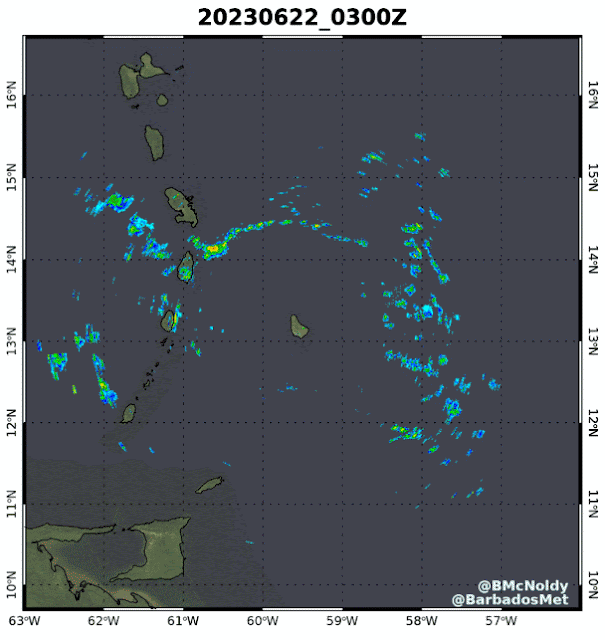Named storms forming in June are not that uncommon -- in the past three decades there have been thirty of them. But of those thirty, only two formed in the deep tropics east of the Caribbean (Bret 2017 and Bonnie 2022).
Having two simultaneous named storms in June is exceptionally rare -- it's happened just once before in 1968 (Brenda and Candy).
Now in 2023, not only are there two named storms during June in the Atlantic, they're active simultaneously and both formed from African easterly waves east of the Caribbean. This unprecedented event is undoubtedly enabled by the record-breaking ocean temperatures in the eastern tropical Atlantic and the related relative dearth of dry Saharan air plumes.
Tropical Storm Bret crossed the Lesser Antilles on Thursday night as a strong tropical storm as forecast, and is now in the eastern Caribbean Sea where a much more hostile environment awaits it. Tropical Depression Four was upgraded to Tropical Storm Cindy on Thursday night and will almost certainly miss the Lesser Antilles.
The satellite loop below shows Bret as of Friday morning, but the NHC forecast (and most model guidance) indicates that the storm will dissipate by Sunday as the wind shear picks up significantly. The track forecast takes it due west, so impacts to land in its final days will be minimal.
Cindy, on the other hand, has several days of activity ahead of it before it reaches an area of high wind shear. Model guidance generally keeps it below hurricane intensity, but there's a shot at it this weekend before it begins to weaken again. The official NHC forecast as of Friday morning is shown below, and the track guidance from models is pretty tightly clustered.
Given that these two storms have limited time before wind shear overwhelms them, this will likely be my last update on them. Elsewhere across the basin all is quiet, but the next name on this year's list is Don. Cindy formed *40 days* before the average date of third named storm formation, so there's no doubt this season is off to a strong start. If Cindy does manage to become the season's first hurricane this weekend, you can see just how anomalously early that would be!
- Visit the Tropical Atlantic Headquarters.
- Subscribe to get these updates emailed to you.
- Follow me on Twitter

















.gif)






 The official Atlantic Hurricane Season spans June 1 through November 30, and coincidentally, Tropical Depression 2 formed on June 1... and was just upgraded to Tropical Storm Arlene on June 2. Although it's located right off the Florida peninsula, there is no cause for concern. There is zero guidance suggesting this will intensify beyond where it's at now.
The official Atlantic Hurricane Season spans June 1 through November 30, and coincidentally, Tropical Depression 2 formed on June 1... and was just upgraded to Tropical Storm Arlene on June 2. Although it's located right off the Florida peninsula, there is no cause for concern. There is zero guidance suggesting this will intensify beyond where it's at now.


